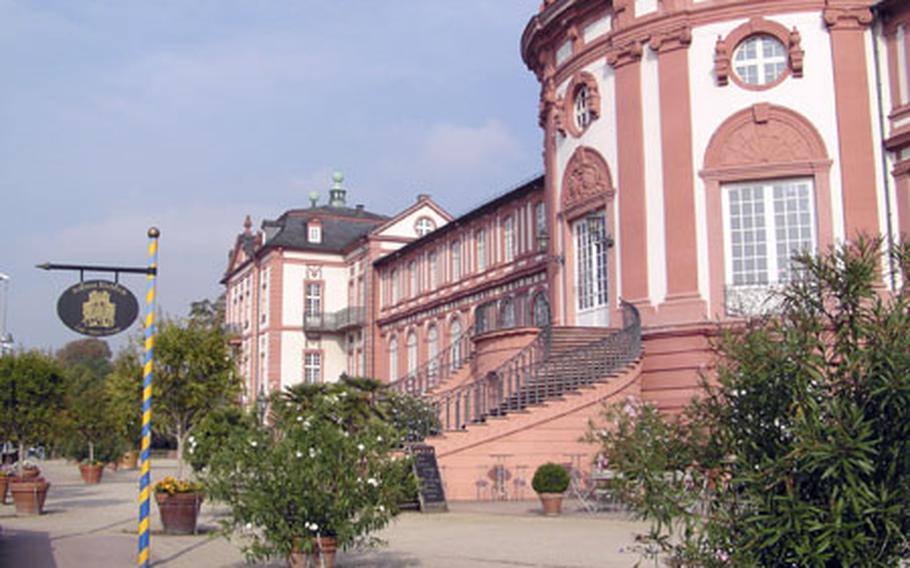
The Baroque palace, built between 1700 and 1745, is now the home to a restaurant and several state office buildings. (Mecki Snippen / S&S)
For most people, the first — and sometimes only — glimpse of the Biebrich palace is from a boat on the Rhine River. But the palace and the surrounding park are worth a closer look.
The beautiful Baroque palace near Wiesbaden, Germany, was built between 1700 and 1745 by the Duke of Nassau, who had been living in Idstein, but wanted to move from the “country.”
Construction began with the west pavilion, completed in 1702, and a separate east pavilion, about 275 feet away, that was intended to be the residence of the lady of the house. In 1707, the architect was authorized to complete connecting the two with a long central hallway and galleries.
Changes were made to the palace in 1828. The building stopped being the residence in 1841 when the Wiesbaden residential palace was completed, serving instead as the summer residence of the Dukes of Nassau. The east wing was destroyed during World War II and subsequently rebuilt.
Today it is home of several offices of the State of Hesse, and a restaurant famous for its wine selection. Its steps and the building are a popular background of wedding photos.
The park is vast and beautiful, with the initial plan calling for a French garden stretching inland from behind the palace. It eventually included a lake and an artificial ruin of a fortress, built in 1804. It has become a popular place for families, joggers, picnickers and others to go for a day of relaxation.
If you arrive in the morning, the first sounds you will hear are the cries of birds foreign to this part of the world. The old trees in the park have become home to more than 1,000 parrots. The original parrots were birds that had escaped captivity. Obviously, they adapted well to their surroundings.
The park’s greenhouses and rare plants were sold to Frankfurt in 1866, forming the basis of that city’s botanical garden.
Once a year, the park is the site of an international horse competition. The event, first held in 1929, has been attracting riders and spectators from around the world. This year it will be held May 25-28.
Tents and umbrellas are set up for guests, and exquisite food delicacies as well as drinks may be purchased on the premises. In the evenings, special events take place under floodlights. This event is definitely a must for everyone who loves horses.
The park’s monthly flea markets have started up again for the season. They are held every third Saturday of the month, beginning this week and ending Oct. 20.
The market has few professional vendors. Most stands are put up by people who sell things they don’t need any more, or which they inherited and have no room for.
The atmosphere is nice. Wiesbaden inhabitants have a peculiar, pleasant sense of humor. They are relaxed and seem to have fun selling their “treasures.” The spaces, which are quite reasonable, are rented through the city, so there is some control over who may sell goods there.
Of course, you can buy the usual German snack food at the market. There is a vendor who sells coffee, cold drinks, bratwurst, fries and even home-baked cake.
On the QT
Directions: Take A3 or A5 to the intersection with A66. Leave the autobahn at exit 4, Wiesbaden-Biebrich, turn left onto Biebricher Allee and follow it into town. After about two miles you will reach the Rhine River. Turn right and go two blocks; parking is alongside a wall behind the palace and on side streets. On horse competition days, visitors are advised to use public transportation since parking is limited. From the main train station, take bus No. 4 or 14 toward Biebrich and get off at the palace.
Times: The park is open year round. The palace can be visited by guided tours only one Thursday per month from March through November starting at 4:30 p.m. Those dates are: March 22, April 19, May 24, June 27, Sept. 27, Oct. 25, Nov. 22. (It is closed for renovations in July and August.) Meeting point is at park side in front of the rotunda. English-speaking guides are available.
Costs: The palace tour costs 5 euros. Parking and entrance to the park are free, except during the horse show. Tickets, available April 2, can be ordered by e-mailing tourist information@wiesbaden.de or calling 0611-1729-930.
Food: There is a restaurant in the palace and plenty of places in the city to eat.
Information: For more on the palace and park, see the Web site www.wiesbaden.de (there is an English section), call 0611-306-655 between 9 a.m. and noon Tuesday through Friday; or e-mail kvv-wiesbaden@t-online.de.
— Mecki Snippen